The module is in active development, and as such, it is subject to significant changes as we refine our approach and methodologies to best support our goals. visit: https://neurons.me to learn more.
NetGet streamlines the orchestration of digital domains with the simplicity of a pedal's press, enabling seamless symphonies across networked realms. Acts as a dynamic conduit, directing internet traffic to local services. Inspired by the vast digital landscapes of cyberpunk lore.
Visit netget.me
Install NetGet via npm:
npm install netgetImport NetGet in your Node.js application:
import { Gateway } from 'netget';
// Initialize and configure your Gateway
const gateway = new Gateway();
gateway.listen();Now you can:
npm startYour main application and the gateway will be hosted at localhost.
NetGet relies on a domains.json file for routing configuration, structured as follows:
{
"name": "YourDomainConfigName",
"domains": {
"example.com": "exampleHandler",
"anotherdomain.com": "anotherHandler"
}
}Each domain key maps to a handler module that exports a function to handle requests for that domain.
By default, NetGet searches for a domains.json configuration in the ./config directory, streamlining the setup process.
NetGet is particularly useful in environments where multiple services or applications must be accessible through a single entry point, commonly known as a reverse proxy setup.
Scenario: Local and Remote NetGet Interaction Local NetGet Setup: On your local machine, NetGet operates within your Node.js environment, managing local traffic and processing requests according to your configured rules. It doesn't directly face the internet and instead communicates with an external NetGet instance that does.
Remote NetGet as a Reverse Proxy: The main.netget.me hosted on Nginx acts as your gateway to the internet. It receives internet traffic and forwards it to the appropriate local NetGet instance based on the domain routing configured.
Handshaker Mechanism: For machines not directly accessible via a public IP, the remote NetGet instance (main.netget.me) can act as a handshaker. Your local NetGet instance communicates with this handshaker, which then relays traffic between the internet and your local network.
In a microservices architecture, NetGet can route requests to different services within your infrastructure, making it an ideal solution for developers looking to scale their applications horizontally. Each service can have its own domain, and NetGet will ensure that requests are forwarded to the correct service.
For personal web hosting, NetGet provides an easy-to-set-up gateway for routing traffic to various self-hosted applications. Users with several web applications running on a home server can use NetGet to manage access to these applications through different domains.
Combined with authentication layers, NetGet can control access to various parts of a web infrastructure, ensuring that only authorized users can access specific services.
With NetGet, the complexity of setting up a domain routing system is abstracted away. Users can define their routing logic in a simple JSON configuration file, making the management of domain routes straightforward and maintainable.
NetGet can be extended to include load balancing capabilities, distributing incoming requests across multiple instances of a service to balance the load and improve performance.
By using NetGet, developers and system administrators can create a more organized and efficient network topology, where the flow of requests is handled systematically, aligning with the concept of futuristic control and management of digital spaces.
this.me - this.audio - this.text - this.wallet - this.img - this.pixel - be.this - this.DOM - this.env - this.GUI - this.be - this.video - this.atom - this.dictionaries
Each module in all.this represents a specific datastructure. These classes encapsulate the functionalities and data specific to their domain.
all.this not only aggregates these modules but also provides utilities to facilitate the integration, management, and enhancement of these data structures. For example:
The integration with cleaker ensures each module instance has a unique cryptographic identity, enhancing security and data integrity.
visit: Neurons.me Glossary
-
License: MIT License (see LICENSE for details).
-
Privacy Policy: Respects user privacy; no collection/storage of personal data.
-
Terms of Usage: Use responsibly. No guarantees/warranties provided. Terms | Privacy
Learn more at https://neurons.me
Author: SuiGn

